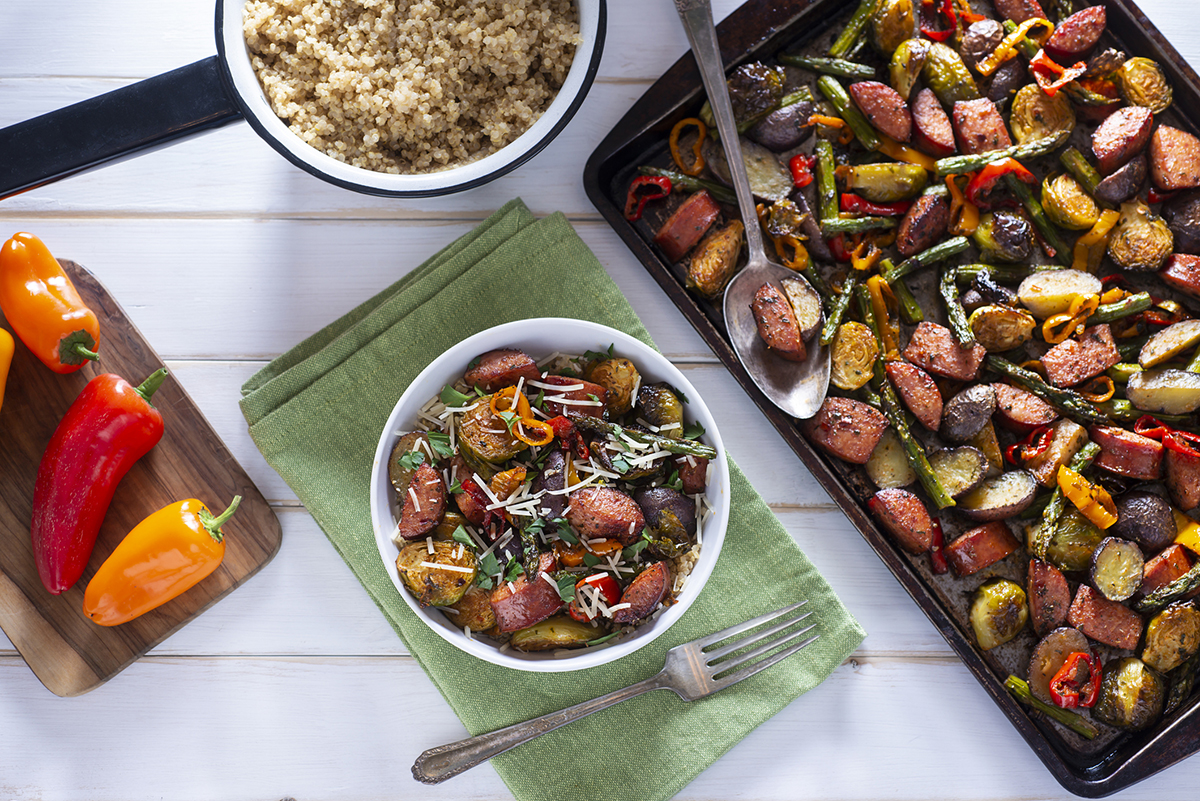Wellness Tips: Sheet-Pan Suppers Save the Day
- by bonappetit
 I want to make healthy, filling meals, but I’m strapped for time. How can I avoid falling into the salad rut?
I want to make healthy, filling meals, but I’m strapped for time. How can I avoid falling into the salad rut?
Do you find it a struggle to make dinner after a long day? You’re not alone — but you’re also not out of luck. Making a healthy, yet easy, dinner is possible with one little culinary trick: sheet-pan cooking.
What is a sheet-pan meal? Exactly like it sounds — an entire dinner cooked on a shallow baking sheet. A sheet pan has four raised edges, about .5- to 1-inch tall, versus a cookie sheet, which has only one raised edge so cookies can slide off easily. Roasting a whole dinner in one pan cuts down on dinner prep time, eliminates the need for fancy equipment or ingredients, makes after-meal clean-up a breeze, and usually offers lunch leftovers the next day!
Planning a sheet pan dinner is easy. Simply follow these four steps to build a flavorful dinner:
- Choose your vegetables. Any vegetables will do, but try for a mix of both non-starchy (broccoli, peppers, onions, kale, etc.) and starchy vegetables (sweet potatoes, squash, root vegetables, etc.) for maximum meal satiety. If you’re picking multiple vegetables that might cook at different rates, plan to segregate them for easier removal mid-cooking when they’re done. Keep in mind that vegetables cook down considerably when roasting, so don’t be stingy when adding plants to your pan!
- Add protein to round out the meal. While the vegetables are the star of sheet pan dinners, including a plant- or animal-based protein will make it nutritionally complete. Whether you choose tofu, tempeh, poultry, fish, or beef, plan for about 2 to 4 ounces per serving, and keep in mind that some proteins need longer to reach a safe temperature.
- Add fat and flavorings, and roast at high heat until golden brown. The final step in an easy sheet pan dinner is adding flavor! A parchment-paper or aluminum-foil liner on your baking sheet makes clean-up a snap. Add a little healthy fat to the pan to coat vegetables and protein and help everything brown easily: 1-2 teaspoons of olive, grapeseed, or sunflower oil are great choices. Add your vegetables and protein, then sprinkle some herbs and spices for depth of flavor, or get creative and include a few smashed garlic cloves, lemon slices, or fresh chiles to the mix. Toss the ingredients in the oil to coat everything lightly, then move the pieces around so they’re in a single layer. Finally, roast the pan at high heat (about 400 degrees) until vegetables are golden brown and protein is cooked through, usually about 40 to 60 minutes. Check every 10 minutes or so, and if anything is starting to overcook, remove it and set aside.
- Serve with a whole grain (optional): For extra oomph, add a side of brown rice, quinoa, wheat berries, or other whole grain of choice.
The beauty of sheet-pan meals is that almost everything — from vegetable fajitas, roasted chicken, and even salmon and asparagus — can be cooked on a baking sheet. Need recipe inspiration? Check out a few of our favorite healthy sheet-pan dinner recipes to get ideas for easy dinners flowing.
- Sheet Pan Roasted Squash and Feta Salad
- Citrus Marinated Tofu with Onions and Peppers
- Sheet Pan Chipotle Lime Shrimp Bake
At Bon Appétit, we know there’s a lot on your plate that you worry about. That’s why we have a team of registered dietitian nutritionists ready to answer your nutrition questions about which food choices will help you avoid unwanted pounds, work or study (and sleep!) better, and form long-lasting healthy eating habits. Email your questions and feedback to [email protected].